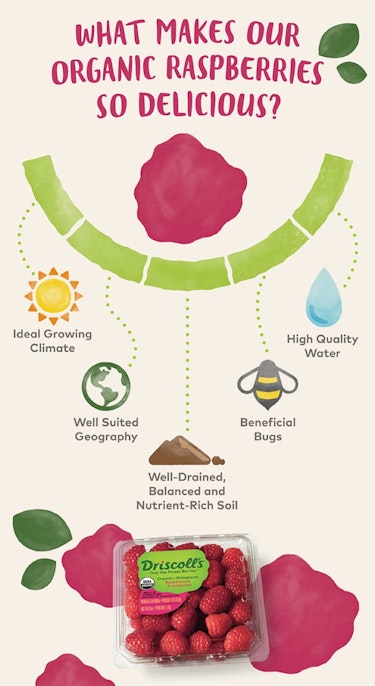Organic Raspberries 101: A Visit with Driscoll’s Supply Director, Carmelo Sicairos

At Driscoll’s, we’re lucky enough to have a resident expert on all things raspberry—and even more specifically, organic raspberries. With over 30 years’ experience in raspberry production, from his early days as a crew boss to his current role as supply director, Carmelo Sicairos is our go-to guy for organic raspberries. As our Supply Director for Driscoll’s of the Americas, Carmelo oversees raspberry planning and forecasting.
Recently, we sat down with Carmelo to get the scoop on the best time of year to enjoy organic raspberries, what it takes to grow them organically, and how he envisions the future of organic raspberry farming. Fair warning: after all this organic raspberry talk, you may be hungry for a handful.
A YEAR-ROUND PURSUIT
For decades now, the Joy Maker team at Driscoll’s has been in pursuit of a consistent, year-round supply of our full berry patch, including strawberries, raspberries, blackberries and blueberries. Through advances in breeding and growing systems, we’re improving the consistency of our organic raspberry supply. “With advances such as container growing systems—a practice where berries are grown in pots—we have better control over their environment,” Carmelo tells us. “We believe this practice will improve the reliability of our organic raspberry supply year-round.”
Carmelo likens this growing method to something we can all relate to: house plants. “In a more controlled environment, we can monitor plant health more closely and provide optimal growing conditions—it’s very similar to how household plants are grown,” he adds.
Despite decades of fine-tuning, Carmelo admits there’s still work to be done. “The fact is, there are still peaks of supply during the late spring and fall,” he says. The good news for organic raspberry lovers in the U.S.? Right now is an excellent time to enjoy these delicious, organically grown jewels.
A COMMITMENT TO ORGANICS
If you’ve ever enjoyed a handful of organic raspberries, chances are they were Driscoll’s berries. Nearly ninety percent of the organic raspberries on the market carry the Driscoll’s label. Despite being the market leader, there continues to be more demand for our delicious organic raspberries than there is supply. (A good problem to have, right?)
Carmelo shares with us that organic farming takes dedication—along with an incredible amount of resources and hard work. “Farming organic raspberries is a commitment,” Carmelo tells us. “There are many factors that need to align in order to create the best quality organic raspberries.”
One of the main factors is the right geography; raspberry plants have proven to be picky when it comes to their preferred climate. “Our independent growers have found a few small pockets where raspberries—both organic and conventionally grown—truly flourish,” Carmelo says. Other factors include securing the right piece of land and adding the right organic inputs to help the raspberry plants flourish, like natural fertilizers and living organisms such as microbes and bees.
Another important factor is practicing strategic soil rotation, as Carmelo shares with us through an eye-opening anecdote. “Soil rotation is an example of an important organic farming practice that takes years to really understand and master,” he says. “It takes years to balance soil so that it offers an optimal growing environment for organic raspberry production—and a week to completely damage it. One season, a Driscoll’s independent grower lost many acres of his organic raspberry crop after missing a single irrigation cycle. Though he had the right location and the right soil profile, the crop didn’t get the nutrients it needed from the water.” Suffice it to say, organic raspberry farming is a delicate balance of environment, commitment, and know-how.
ORGANICS OF THE FUTURE
It’s no secret that water, land, and labor are increasingly pressing issues for today’s berry farmers. Add to those challenges the fact that organic farmers tend to spend more money for less crop yield. “Organic growers typically see lower yields, which translates into lower fruit density on the plant,” Carmelo shares. “And because every raspberry is hand-picked, harvesters have increased walking time to find the berries.” With these increasing complications, we asked Carmelo, how does Driscoll’s plan to remain the market leader for organic raspberries?
To come full circle, Carmelo says it starts with how organic raspberries are grown. “The ability to grow raspberry plants in pots would provide much greater control on water and soil quality,” he adds. “Additionally, it would allow for greater density—you can arrange the plants closely together—which would cut down on the time required to harvest the berries.”
After posing this question, Carmelo reminds us of the larger vision. “At Driscoll’s, part of our vision statement is to enrich the lives of everyone we touch, from the consumer, to the laborers who plant and harvest the fruit, to the communities in which we do business,” he says. “As we’ve learned that employees often have a preference for the work environment that organic ranches offer, we feel it’s very much in line with our long term vision to invest meaningfully in the growth of our organics category.”
The next time you find yourself in the produce section, pondering whether to buy a package of Driscoll’s organic raspberries, you can rest assured that the meticulous research, careful planning, and hard work that went into those organic berries is reflected in their bright color, delicate texture and juicy flavor. Now, who’s ready for a handful of raspberries?
